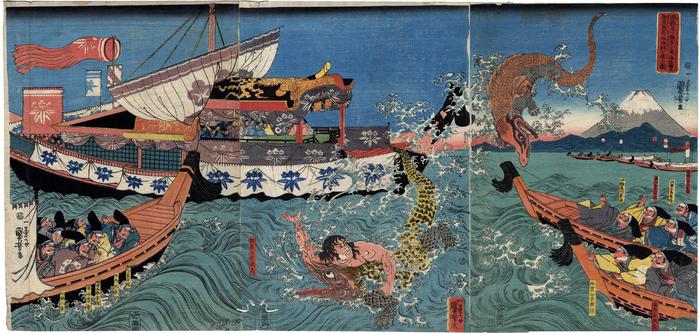Utagawa Kuniyoshi (歌川国芳) (artist 11/15/1797 – 03/05/1861)
Asahina Yoshihide Fighting Crocodiles on the Occasion of Minamoto no Yoriie's Sea Viewing at Kotsubo - Minamoto no Yoriie-kō Kamakura Kotsubo no umi yūran Asahina Yoshihide shiyū no wani wo tōfu zu (源頼家公鎌倉小壷海遊覧 朝夷義秀雌雄鰐を捕ふ図)
ca 1843 – 1846
30 in x 14 in (Overall dimensions) Japanese color woodblock print
Signed: Ichiyūsai Kuniyoshi ga
一勇齋国芳画
Publisher: Sōshūya Yohei (Marks 485 - seal 21-082)
Censor's seal: Hama
Pushkin Museum of Fine Arts - left and center panels only
Harvard Art Museums - center panel
National Museums Scotland
Muzeum Sztuki i Techniki Japońskiej Manggha, Krakow
Royal Museums of Art and History, Belgium (via Cultural Japan)
Tokyo Fuji Art Museum - dated to 1843
Tokyo Metropolitan Library
Lyon Collection - an earlier triptych of this scene by Kuniyoshi from 1849 13th century Asahina Saburō Yoshihide’s fight with two crocodiles in the sea off Kamakura, watched by the Shogun Yoriiye and his nobles in boats. Robinson T119. One of Kuniyoshi’s best designs.
Illustrated in color in Japanese Warrior Prints 1646-1905 by James King and Yuriko Iwakiri on page 281.
****
This incident, real or otherwise, is recorded in the 13th century 'Mirror of the East', the Azuma kagami (吾妻鏡), Minamoto no Yoriie visited the area around Kotsubo where he performed certain rites expected of a member of his clan. Later while cruising nearby he ordered Asahina to jump into the water to show the rest of his retinue how good a swimmer he was. Much to everyone's surprise and joy Asahina dove in and when he came back up he had caught three sharks - which eventually morphed into the crocodiles seen here. This event was said to have taken place on the second day of the ninth month of Shōji (正治2年9月2日), approximately the year 1200.
****
"Asahina Saburō... once, while on a voyage, jumped overboard, took hold of two sharks and swam about holding one under each arm. Instead of with the sharks he is sometimes depicted holding on to two crocodiles."
Quoted from: The Animal in Far Eastern Art: And Especially in the Art of the Japanese Netsuke, with References to Chinese Origins, Traditions, Legends, and Art by T. Volker, p. 38.
****
The use of 'wani' (鰐) in the title -
"Taoists in China credited the crocodile with an ability to summon spring rains and viewed it as a type of dragon. In line with this belief, ancient Chinese rain-making ceremonies sometimes employed drums covered in crocodile skin. From ancient times, the Japanese used the word wani to designate a sea monster. When the Chinese system of writing was adopted, wani was written with the ideograph [鰐] for crocodile, and it is thus likely that most references to crocodiles in early documents and myths refer not to the crocodile specifically but rather to a generic sea monster.
In Japan, crocodiles figure in a number of legends of Chinese pedigree. Further, a type of hollow wooden drum in the shape of a fish head, associated with Shinto observances, is known as a wani-guchi (crocodile mouth)."
Quoted from: Symbols of Japan: Thematic Motifs in Art and Design by Merrily Baird, p. 129.
warrior prints (musha-e - 武者絵) (genre)
Sōshūya Yohei (総州屋与兵衛) (publisher)
Yūrei-zu (幽霊図 - ghosts demons monsters and spirits) (genre)
Asahina Saburō (朝比奈三郎) (role)
